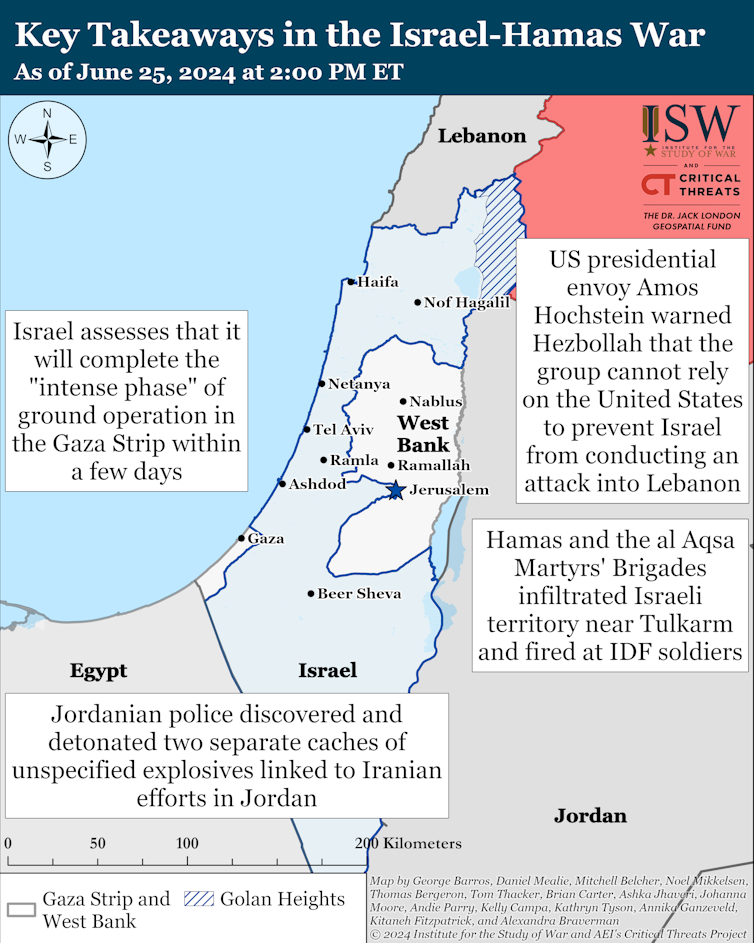It was the moment that Israel’s military acknowledged the failure of its eight-and-half month war in Gaza – certainly the mission set out by the prime minister, Benjamin Netanyahu, when he said after the October 7 Hamas attack that he would destroy the militant group.
On June 19 the spokesperson for the Israel Defense Forces (IDF), Rear Admiral Daniel Hagari, told Channel 13 News that the aim of eradicating Gaza’s leadership was unattainable.
This business of destroying Hamas, making Hamas disappear — it’s simply throwing sand in the eyes of the public. Hamas is an idea, Hamas is a party. It’s rooted in the hearts of the people — anyone who thinks we can eliminate Hamas is wrong.
At one level, the IDF spokesperson was merely restating what analysts had cautioned just after Hamas’ killing of 1,143 people, including 767 civilians, and its abduction of around 250 others. An all-out military assault, from the air and on the ground, would allow Hamas to present itself as the protector of Gaza’s civilians, even as Israel killed many thousands of them.
But, at another level, this was the Israeli military’s challenge to Netanyahu.
Three days earlier Netanyahu had snapped at a cabinet meeting: “To achieve the goal of destroying Hamas’s capabilities I’ve had to make decisions that weren’t always accepted by the military leadership.”
Now the IDF was effectively saying to the prime minister that his plan A of destroying Hamas was not viable. So what is plan B?
In Hagari’s words: “If the government doesn’t find an alternative – [Hamas] will remain in Gaza.”
Netanyahu’s perpetual war
The prime minister’s office refused to give way to the military, responding to Hagari’s interview by insisting: “[We have] defined as one of the war goals the destruction of Hamas’s military and governance capabilities.”
In a tactical retreat, the IDF issued another statement that it was committed to stated war goals, including destroying Hamas’s governing and military abilities. Hagari had merely spoken about “eradicating Hamas as an ideology and an idea”.
But the commanders, and Netanyahu, knew that the warning bell could not be unrung – particularly, as only ten days earlier, former IDF commander Benny Gantz had fired his own shot at the prime minister.
On May 18, Gantz – one of the three members of the war cabinet – gave Netanyahu a three-week ultimatum. In a televised address, he said the prime minister had put his personal and political interests ahead of the existential needs of the state of Israel, allowing “hard-right zealots” to put the country at risk.
Among Gantz’s six strategic demands were priorities on a return of hostages and a new political leadership in Gaza, rather than on the “destruction” of Hamas.
Netanyahu rejected all the demands, including a timeframe for a path towards a state of Palestine along Israel’s normalisation with Arab countries. On June 9, Gantz left the war cabinet – and the prime minister dissolved the body a week later.
No plan (either A or B)
This has only prolonged Netanyahu’s dilemma. The day that a Gaza ceasefire is announced, he will be in political and legal jeopardy unless Hamas no longer exists.
Early elections will probably follow in Israel, and he is far behind Gantz and the National Unity Party in polling. Perhaps more importantly, he will face bribery charges which have effectively been suspended by the war.

But there is no prospect of his promised destruction of Hamas. Or that Gaza’s civilians, facing death, starvation, and deprivation each day, will rise up against the leadership.
In a rare enforcement of a “red line”, the US checked any plan for an all-out ground assault on Rafah. To hold off pressure, Netanyahu has made vague statements about a redeployment of the army, while persisting with bombs on Hamas and civilian alike.
So with no plan B, what does Netanyahu do to stem the pressure upon him from inside and outside Israel? He plays for time. In the past week, Netanyahu has said he supports only a “partial” hostage deal with Hamas, so Israel could resume fighting after women, the elderly, and sick were released.
He has picked a fight with the US about the supply of American weapons for Israel’s war. And he has threatened to expand the fighting with Hezbollah across the Lebanese border in the north.
None of these are a Gaza plan B. They are Netanyahu’s personal plan A. Throw out a daily distraction or diversion to avoid a media focus on the ceasefire talks, on the carnage in Gaza, or on the failure to “destroy” Hamas.
The IDF’s warning, combined with Gantz’s departure from the war cabinet is a signal that they are weary of an open-ended assault with no political vision.
But when will that weariness lead to a decisive rejection of Netanyahu’s approach? For now, given that the defence minister, Yoav Gallant, has not indicated he will make a break – and given the pressure from hard-right ministers to ethnically cleanse Gaza in a long-term occupation – that question, like Netanyahu’s options, has no answer.
Scott Lucas does not work for, consult, own shares in or receive funding from any company or organisation that would benefit from this article, and has disclosed no relevant affiliations beyond their academic appointment.
This article was originally published on The Conversation. Read the original article.







